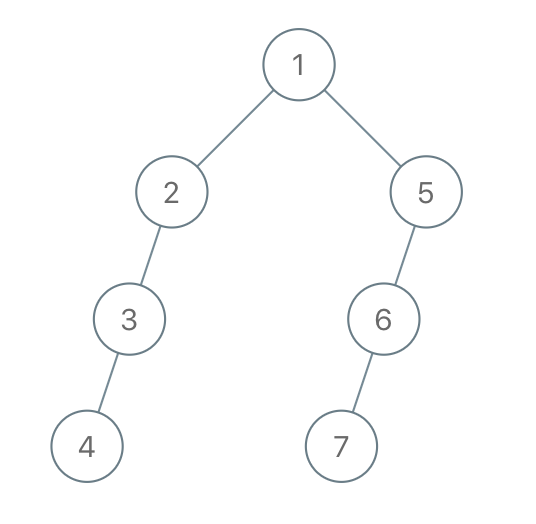1025. Divisor Game
Alice and Bob take turns playing a game, with Alice starting first.
Initially, there is a number
Non the chalkboard. On each player's turn, that player makes a move consisting of:
- Choosing any
xwith0 < x < NandN % x == 0.- Replacing the number
Non the chalkboard withN - x.Also, if a player cannot make a move, they lose the game.
Return
Trueif and only if Alice wins the game, assuming both players play optimally.
Example 1:
Input: 2 Output: true Explanation: Alice chooses 1, and Bob has no more moves.Example 2:
Input: 3 Output: false Explanation: Alice chooses 1, Bob chooses 1, and Alice has no more moves.
Note:
1 <= N <= 1000
Approach #1: Math. [Java]
class Solution {
public boolean divisorGame(int N) {
if (N % 2 == 0) return true;
else return false;
}
}
1026. Maximum Difference Between Node and Ancestor
Given the
rootof a binary tree, find the maximum valueVfor which there exists different nodesAandBwhereV = |A.val - B.val|andAis an ancestor ofB.(A node A is an ancestor of B if either: any child of A is equal to B, or any child of A is an ancestor of B.)
Example 1:
Input: [8,3,10,1,6,null,14,null,null,4,7,13] Output: 7 Explanation: We have various ancestor-node differences, some of which are given below : |8 - 3| = 5 |3 - 7| = 4 |8 - 1| = 7 |10 - 13| = 3 Among all possible differences, the maximum value of 7 is obtained by |8 - 1| = 7.
Note:
- The number of nodes in the tree is between
2and5000.- Each node will have value between
0and100000.
Approach #1: [Java]
/**
* Definition for a binary tree node.
* public class TreeNode {
* int val;
* TreeNode left;
* TreeNode right;
* TreeNode(int x) { val = x; }
* }
*/
class Solution {
public int maxAncestorDiff(TreeNode root) {
return dfs(root, root.val, root.val);
}
public int dfs(TreeNode root, int mx, int mn) {
if (root == null) return 0;
int res = Math.max(root.val - mn, mx - root.val);
mx = Math.max(mx, root.val);
mn = Math.min(mn, root.val);
res = Math.max(res, dfs(root.left, mx, mn));
res = Math.max(res, dfs(root.right, mx, mn));
return res;
}
}
1027. Longest Arithmetic Sequence
Given an array
Aof integers, return the length of the longest arithmetic subsequence inA.Recall that a subsequence of
Ais a listA[i_1], A[i_2], ..., A[i_k]with0 <= i_1 < i_2 < ... < i_k <= A.length - 1, and that a sequenceBis arithmetic ifB[i+1] - B[i]are all the same value (for0 <= i < B.length - 1).
Example 1:
Input: [3,6,9,12] Output: 4 Explanation: The whole array is an arithmetic sequence with steps of length = 3.Example 2:
Input: [9,4,7,2,10] Output: 3 Explanation: The longest arithmetic subsequence is [4,7,10].Example 3:
Input: [20,1,15,3,10,5,8] Output: 4 Explanation: The longest arithmetic subsequence is [20,15,10,5].
Note:
2 <= A.length <= 20000 <= A[i] <= 10000
Approach #1: [Java]
class Solution {
public int longestArithSeqLength(int[] A) {
if (A.length <= 1) return A.length;
int longest = 0;
Map<Integer, Integer>[] dp = new HashMap[A.length];
for (int i = 0; i < A.length; ++i)
dp[i] = new HashMap<Integer, Integer>();
for (int i = 1; i < A.length; ++i) {
for (int j = 0; j < i; ++j) {
int d = A[i] - A[j];
int len = 2;
if (dp[j].containsKey(d)) {
len = dp[j].get(d) + 1;
}
int curr = dp[i].getOrDefault(d, 0);
dp[i].put(d, Math.max(len, curr));
longest = Math.max(longest, dp[i].get(d));
}
}
return longest;
}
}
Analysis:
We iteratively build the map for a new index i, by considering all elements to the left one-by-one. For each pair of indeces (i, j) and difference d = A[i] - A[j] considered, we check if there was an existing chain at the index j with difference d always.
If yes, we can then extend the existing chain length by 1.
Else, if not, then we can start a new chain of length 2 with this new difference d and (A[j], A[i]) as its elements.
At the end, we can then return the maximum chain length that we have seen so far.
1028. Recover a Tree From Preorder Traversal
We run a preorder depth first search on the
rootof a binary tree.At each node in this traversal, we output
Ddashes (whereDis the depth of this node), then we output the value of this node. (If the depth of a node isD, the depth of its immediate child isD+1. The depth of the root node is0.)If a node has only one child, that child is guaranteed to be the left child.
Given the output
Sof this traversal, recover the tree and return itsroot.
Example 1:
Input: "1-2--3--4-5--6--7" Output: [1,2,5,3,4,6,7]Example 2:
Input: "1-2--3---4-5--6---7" Output: [1,2,5,3,null,6,null,4,null,7]Example 3:
Input: "1-401--349---90--88" Output: [1,401,null,349,88,90]
Note:
- The number of nodes in the original tree is between
1and1000.- Each node will have a value between
1and10^9.
Approach #1: [Java]
/**
* Definition for a binary tree node.
* public class TreeNode {
* int val;
* TreeNode left;
* TreeNode right;
* TreeNode(int x) { val = x; }
* }
*/
class Solution {
int index = 0;
public TreeNode recoverFromPreorder(String S) {
return helper(S, 0);
}
public TreeNode helper(String s, int depth) {
int numDash = 0;
while (index + numDash < s.length() && s.charAt(index+numDash) == '-') {
numDash++;
}
if (numDash != depth) return null;
int next = index + numDash;
while (next < s.length() && s.charAt(next) != '-') next++;
int val = Integer.parseInt(s.substring(index + numDash, next));
index = next;
TreeNode root = new TreeNode(val);
root.left = helper(s, depth + 1);
root.right = helper(s, depth + 1);
return root;
}
}



